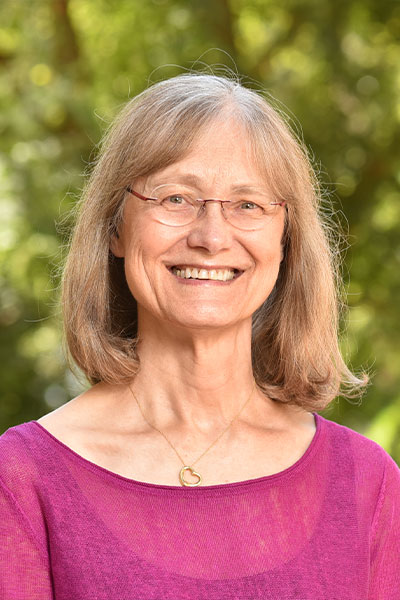Patricia Phelps
Professor

Office: 1024 TLSB
Phone: (310) 825-7264
Website: http://www.physci.ucla.edu/research/phelps/index.php
Biography
Dr. Patty Phelps received her BS and BA degrees from Washington University in St. Louis and her PhD from the Department of Anatomy at UCLA. She then moved to the City of Hope Research Institute in Duarte, California where she received her Postdoctoral training in the Neuroscience Division with Dr. James Vaughn. In 1995, she joined UCLA as an Assistant Professor in the Department of Physiological Science, which is now named the Department of Integrative Biology and Physiology. For many years Dr. Phelps has served as the Vice-Chair for Undergraduate Education in the department and also was the Faculty Director for the Amgen Scholars Program from 2006-2017. Her teaching focuses on the Systems Anatomy class taken by all entering Physiological Science majors and her upper division elective on the “Principles of Nervous System Development.” Based on the extensive multimedia teaching tools she developed and uses in her classes, together with her teaching excellence, she received the UCLA Distinguished Teaching award in 2011.
Research Interests
Our research focuses on the molecular and cellular interactions that control spinal cord development and regeneration after injury. Currently we study the effects of neuronal migratory errors identified in the dorsal horn of the reeler spinal cord. Reelin is a secreted glycoprotein that binds the lipoprotein receptors Vldlr and Apoer2, is internalized, and activates a tyrosine kinase cascade that phosphorylates the intracellular adaptor protein Disabled-1 (Dab1). The Reelin-signaling pathway regulates neuronal positioning in the spinal cord in a cell-specific manner; distinct subsets of neurons sustain migratory errors while others are correctly located. Our laboratory has uncovered migratory errors in the dorsal horn of reeler and dab1 mutants during development and in adults. Importantly, both reeler and dab1 mutants show an increased sensitivity to heat and a profound reduction in mechanical sensitivity. Our findings indicate that Reelin and Dab1-expressing neurons are essential contributors to the normal development of circuits that underlie thermal and mechanical pain processing.
A second focus of the laboratory is to study axon regeneration following complete spinal cord transection. Together with Dr. Edgerton’s lab at UCLA we have completed four extensive studies in which olfactory bulb-derived olfactory ensheathing cells (OECs) were transplanted into the spinal cord after a transection at thoracic level T8. We found that adult spinal rats transplanted with OECs had, relative to control rats receiving medium or fibroblast transplants: 1) improved locomotor performance during hindlimb treadmill stepping, 2) motor evoked potentials induced with transcranial electric stimulation that were lost following re-transection above the original injury, 3) evidence of supraspinal and propriospinal regeneration, and 4) a modification of the lesion site in which OECs align with astrocytes to facilitate axon outgrowth across the injury. Results from tissue culture experiments that mimic the inhibitory glial scar at the lesion site show that OECs directly enhance neurite outgrowth compared to fibroblast controls.
Education
B.A., School of Liberal Arts, Washington University, St. Louis 1970
B.S., School of Medicine, Department of Occupational Therapy, Washington University, St. Louis 1970
Ph.D., Anatomy and Cell Biology, University of California, Los Angeles 1982
Selected Publications
Wang, X, Yvonne, GM, Cilluffo, M, Kim, AS, Basbaum, AI, and Phelps, PE, “Mispositioned Neurokinin-1 receptor-expressing neurons underlie heat hyperalgesia in Disabled-1 mutant mice”, eNeuro, 6 (e0131-19): 1-16 (2019) [link].
Thornton, MA, Mehta, MD, Morad, TT, Ingraham, KL, Khankan, RR, Griffis, KG, Yeung, AK, Zhong, H, Roy, RR, Edgerton, VR, Phelps, PE, “Evidence of axon connectivity across a spinal cord transection in rats treated with epidural stimulation and motor training combined with olfactory ensheathing cell transplantation”, Expt. Neurol., 309 : 119-133 (2018) [link].
Yvone, G.M., H.H. Zhao-Fleming, J.C. Udeochu, C.L. Chavez-Martinez, A. Wang, M. Hirose- Ikeda, and P.E. Phelps, “Disabled-1 dorsal horn neurons co-express Lmx1b and function in nociceptive circuits”, Eur. J. Neurosci, 45 : 733-747 (2017) [link].
Khankan, R.R., K.G. Griffis, J.R. Haggerty-Skeans, H. Zhong, R.R. Roy, V.R. Edgerton, and P.E. Phelps, “Olfactory ensheathing cell transplantation after a complete spinal cord transection mediates neuroprotective and immunomodulatory mechanisms to facilitate regeneration”, J. Neurosci., 36 : 6269-6286 (2016) [link].
Fraley, E.R., Z.D. Burkett, N. F. Day, B.A. Schwartz, P.E. Phelps, and S.A. White, “Mice with Dab1 or Vldlr insufficiency exhibit abnormal neonatal vocalization patterns”, Scientific Report, 6:25807 : 1-12 (2016) [link].
Abadesco, A.D., M. Cilluffo, G.M. Yvone, E.M. Carpenter, B.W. Howell, and P.E. Phelps, “Novel Disabled-1-expressing neurons identified in adult brain and spinal cord”, Eur. J. Neurosci., 39 : 579-592 (2014) .
Wang, X., A.H.Babayan, A.I. Basbaum and P.E. Phelps, “Loss of the Reelin-signaling pathway differentially disrupts heat, mechanical and chemical nociceptive processing”, Neuroscience, 226 : 441-450 (2012) .
Ziegler, M.D., D. Hsu, A. Takeoka, H. Zhong, A. Ramon-Cueto, P.E. Phelps, R.R. Roy, and V.R. Edgerton, “Further evidence of Olfactory Ensheathing Glia facilitating axonal regeneration after a complete spinal cord transection”, Expt. Neurol., 229 : 109-119 (2011) .
Takeoka, T., D.L. Jindrich, C. Munoz-Quiles, H. Zhong, R. van den Brand, D.L. Pham, M.D. Ziegler, A. Ramon-Cueto, R.R. Roy, V.R. Edgerton, and P.E. Phelps, “Axon regeneration can facilitate or suppress hindlimb function after Olfactory Ensheathing Glia transplantation”, J. Neurosci., 31 : 4298-4310 (2011) .

612 Charles E. Young Drive East
Box 957246
Los Angeles, CA 90095-7246
(t) (310) 825-4373
(f) (310) 206-9184

